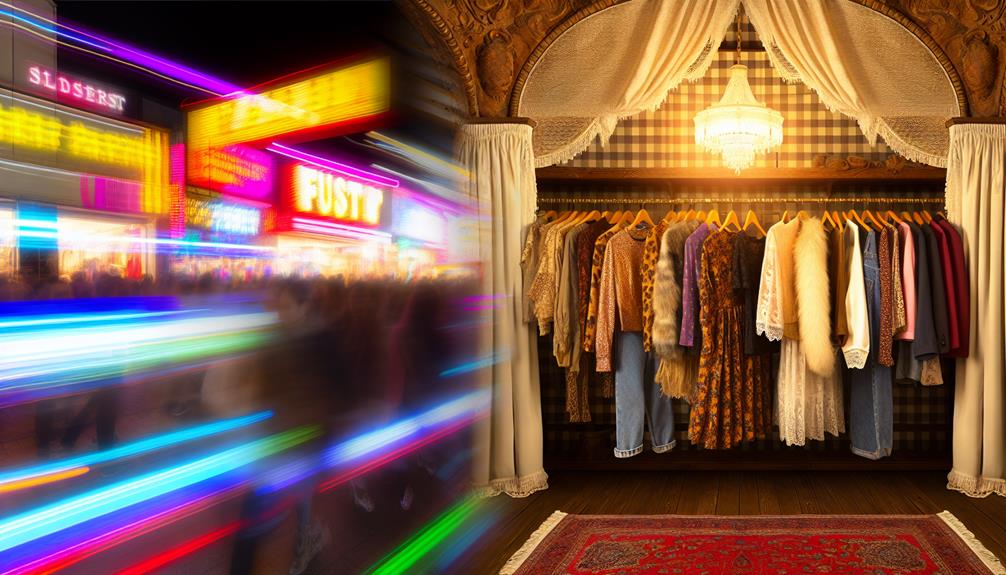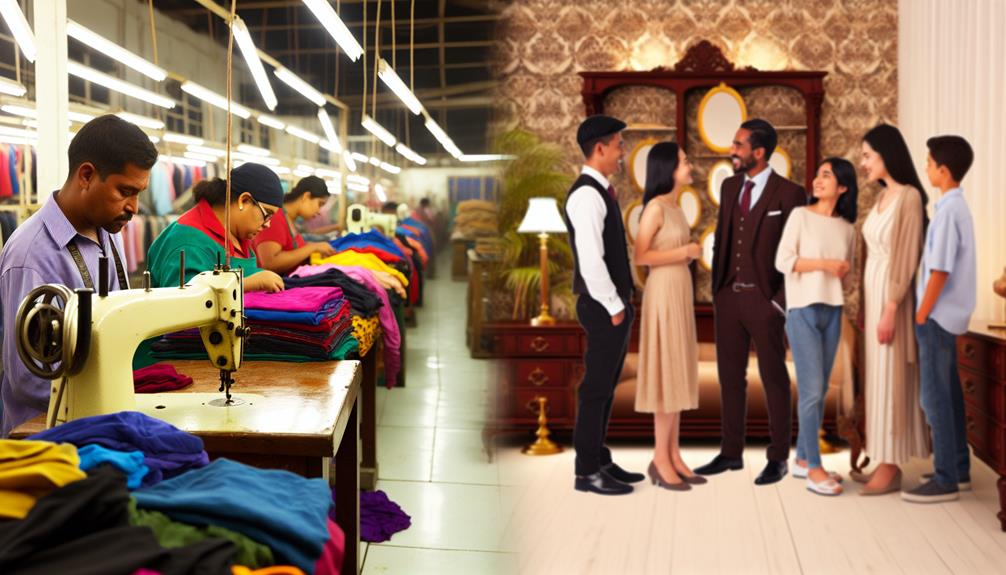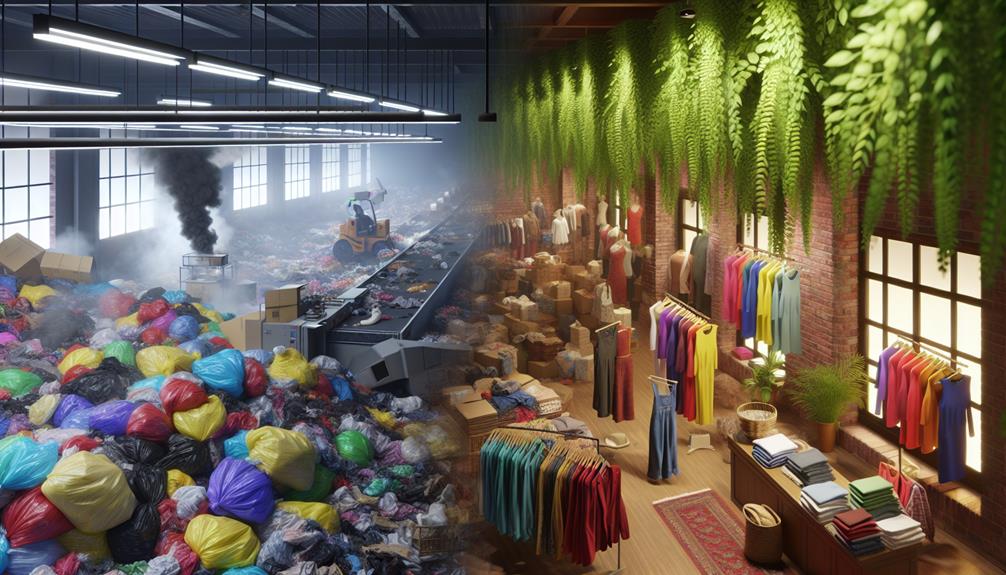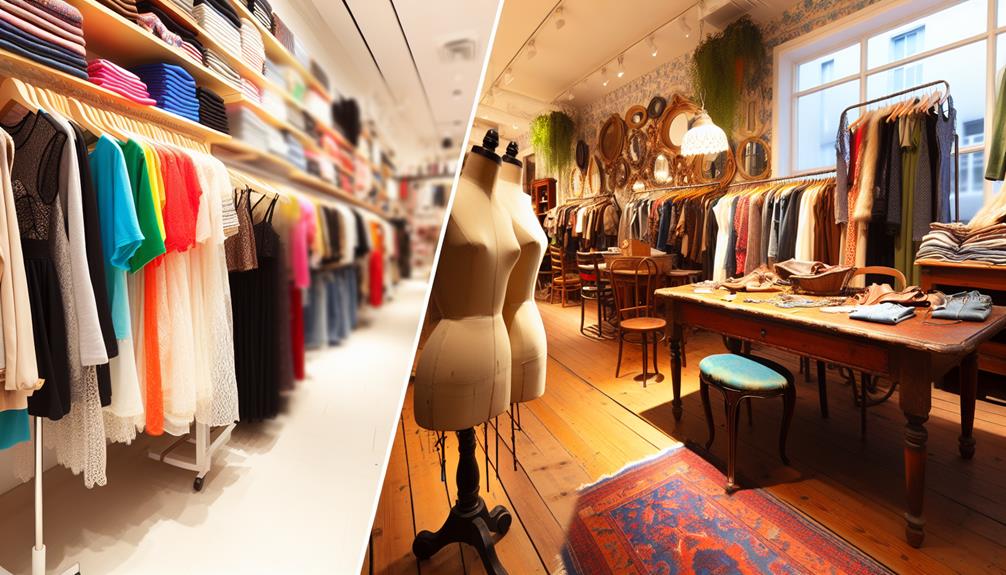
The debate between fast fashion and vintage clothing presents a significant ethical dilemma. Fast fashion prioritizes rapid production, leading to environmental degradation and exploitative labor practices. In contrast, vintage clothing emphasizes quality, sustainability, and individuality, promoting a circular economy that reduces waste. The appeal of vintage lies not only in its unique craftsmanship but also in its support for ethical sourcing and fair wages. As consumers increasingly understand the long-term impacts of their choices, a shift towards responsible fashion emerges. This evolving landscape invites deeper exploration into how our purchasing decisions can shape the future of fashion.
Key Takeaways
- Fast fashion prioritizes rapid production and low costs, leading to environmental degradation and exploitative labor practices in developing countries.
- Vintage fashion promotes sustainability through reuse and recycling, significantly reducing textile waste and carbon footprint compared to fast fashion.
- The vintage market supports ethical labor practices and fair compensation for artisans, fostering dignity and transparency within the fashion industry.
- Consumers play a crucial role in shaping labor practices by choosing sustainable options, influencing brands to adopt ethical practices in their supply chains.
- Embracing vintage fashion allows individuals to express their unique style while contributing to a more responsible and ethical fashion landscape.
Understanding Fast Fashion

As the global apparel industry continues to evolve, understanding fast fashion becomes increasingly vital for consumers and industry stakeholders alike. Fast fashion refers to a retail approach that prioritizes rapid production and turnover of clothing to swiftly respond to shifting consumer preferences. It is characterized by short trend cycles that reflect the latest styles, often seen on runways or social media. This model capitalizes on the fleeting nature of consumer behavior, encouraging shoppers to frequently update their wardrobes. This overconsumption can lead to a detrimental impact on both personal well-being and the environment, highlighting the need for a more balanced approach to fashion that considers wellness metrics and health benchmarks.
The implications of fast fashion extend beyond mere consumer choices; they shape societal norms around clothing consumption and identity. The desire for belonging drives many individuals to conform to the latest trends, resulting in an environment where disposable fashion becomes the norm. This cycle fosters a culture of overconsumption, as consumers feel compelled to purchase new items to maintain relevance within their social circles.
Moreover, the rapid pace of trend cycles often sacrifices quality and sustainability, raising ethical concerns about the environmental impact of such consumption patterns. Understanding fast fashion is vital in maneuvering these complexities, promoting informed choices that align with both personal values and broader societal responsibilities.
The Appeal of Vintage
Vintage clothing has emerged as a compelling alternative to the fast fashion phenomenon, appealing to consumers seeking uniqueness, quality, and sustainability. The allure of vintage lies in its nostalgic charm, evoking memories of bygone eras while providing a canvas for self-expression. Each piece tells a story, allowing wearers to connect with history and culture in a way that mass-produced items cannot replicate. Additionally, the focus on quality often found in vintage garments aligns with the importance of understanding coverage limitations in health decisions, as both emphasize informed choices leading to longer-lasting satisfaction.
In a world dominated by fast fashion's uniformity, vintage clothing offers a rejuvenating escape. Shoppers can cultivate a unique style that distinguishes them from the crowd, fostering a sense of belonging to a community that values individuality over conformity. The intricate craftsmanship often found in vintage garments speaks to a time when quality took precedence over quantity, resulting in pieces that stand the test of time.
Moreover, wearing vintage clothing aligns with a growing consciousness around ethical consumption. By choosing to wear pre-loved items, consumers not only express their personality but also contribute to a sustainable fashion ecosystem. In a landscape increasingly concerned with environmental impact, the appeal of vintage becomes not just about fashion but a commitment to a more thoughtful and responsible way of living.
Environmental Impact Comparison

The environmental implications of fast fashion starkly contrast with the benefits of embracing vintage clothing. Fast fashion is notorious for its significant carbon footprint, stemming from the relentless production cycles and the use of unsustainable materials. Environmental Awareness Days serve as important reminders of the need to reconsider our consumption habits. The rapid turnover of clothing leads to excessive waste, as garments often end up in landfills after only a few wears. This disposable culture not only depletes natural resources but also exacerbates climate change, as the production processes emit vast quantities of greenhouse gases.
In contrast, vintage clothing champions sustainability by promoting the reuse of garments and reducing the demand for new production. Vintage items often embody high-quality craftsmanship and are typically made from sustainable materials, which lessens their environmental impact. By choosing vintage, consumers actively participate in a circular economy, extending the life cycle of clothing and minimizing waste. This choice fosters a sense of belonging and community among like-minded individuals who prioritize ethical fashion. Ultimately, the decision to embrace vintage over fast fashion not only reflects personal style but also signifies a commitment to environmental responsibility, creating a positive ripple effect for future generations.
Ethical Labor Practices
Ethical labor practices represent a fundamental aspect of the ongoing debate between fast fashion and vintage clothing. The fast fashion industry often prioritizes speed and low cost over the welfare of its workers, leading to widespread concerns about worker rights. Many garment workers, primarily in developing countries, are subjected to exploitative conditions, receiving unfair wages that do not reflect the labor they provide. This stark reality contrasts sharply with the vintage clothing market, which often champions ethical sourcing and supports local artisans who are paid fairly for their craftsmanship. Additionally, understanding the impact of indirect manufacturing costs helps consumers evaluate the true cost of their clothing choices, fostering a more informed purchasing decision. In exploring these contrasting paradigms, it becomes evident that the vintage clothing sector nurtures a deeper connection to the labor behind the products. By valuing fair wages and advocating for worker rights, vintage fashion fosters a sense of community and belonging among consumers who prioritize ethical considerations in their purchasing decisions. Choosing vintage is not merely an aesthetic choice; it's a commitment to uphold the dignity of the workers who create our clothing. As consumers become more aware of the ethical implications of their choices, the demand for transparency in labor practices will likely reshape the landscape of fashion consumption.
Making Conscious Choices

Making conscious choices in fashion requires a deliberate examination of the impact that our purchasing decisions have on both the environment and society. As consumers, we must recognize the significance of mindful consumption—an approach that emphasizes quality over quantity and prioritizes ethical implications. Self-assessment and skills evaluation can also play a role in our decision-making process, guiding us to better understand our values in the context of fashion. Fast fashion may offer immediate gratification and affordability, but the long-term consequences are often detrimental to our planet and the workers behind the garments.
In contrast, opting for sustainable alternatives fosters a sense of community and belonging. Vintage clothing, for instance, not only reduces waste but also celebrates individuality and history. By choosing second-hand or ethically produced items, we support brands that prioritize sustainable practices and fair labor conditions, contributing to a fashion ecosystem that values human dignity and environmental stewardship.
Engaging in this shift towards more thoughtful purchasing encourages us to connect with our values and the stories behind our clothing. It transforms fashion from a transient experience into a meaningful expression of identity and ethics. In a world saturated with options, making conscious choices empowers us to forge a path that aligns with our desire for connection, responsibility, and a more sustainable future.
Frequently Asked Questions
How Can I Identify Truly Vintage Clothing?
Identifying truly vintage clothing requires a keen eye for detail. Examine vintage labels, which often feature unique designs and materials indicative of their era. Additionally, assess the fabric quality; authentic vintage garments typically showcase superior craftsmanship and durable textiles. Look for signs of aging, such as fading or wear patterns, which contribute to the garment's character. Ultimately, understanding these elements fosters a deeper appreciation for vintage clothing and enhances your personal style narrative.
What Are Some Affordable Vintage Shopping Tips?
Affordable vintage shopping can be an enriching experience when approached with a strategic mindset. To begin with, cultivate vintage brand awareness by researching notable labels and styles, which enhances your ability to identify valuable pieces. When visiting thrift stores, practice thrift store etiquette: be respectful of the space and other shoppers. Additionally, consider shopping during sales and exploring online platforms to expand your options. By combining these tactics, you can effectively find unique vintage items without overspending.
Is Thrift Shopping Considered Sustainable?
Thrift shopping is widely regarded as a sustainable practice, contributing considerably to thrift store sustainability. By purchasing pre-owned clothing, consumers reduce waste and extend the lifecycle of garments, thereby promoting eco-friendly fashion. This approach not only diminishes the demand for new production, which often has a substantial environmental footprint, but also fosters a sense of community and belonging among like-minded individuals who value ethical consumption. Ultimately, thrift shopping champions a more responsible and inclusive fashion culture.
How Does Fast Fashion Impact Local Economies?
Fast fashion considerably impacts local economies by contributing to job displacement and undermining the livelihoods of local artisans. As mass-produced clothing floods the market, traditional craftsmanship often suffers, leading to a decline in local manufacturing jobs. This shift can erode community identity and cultural heritage, as unique local styles are overshadowed by generic, low-cost alternatives. Ultimately, fostering a sustainable economy necessitates supporting local artisans and preserving the rich tapestry of regional craftsmanship.
Can Vintage Clothing Be Trendy and Fashionable?
Vintage clothing can indeed be both trendy and fashionable, as it embodies vintage aesthetics that resonate with contemporary consumers seeking uniqueness. The allure of timeless style lies in its ability to transcend fleeting fashion trends, offering a sense of belonging to a community that appreciates individuality. By embracing vintage pieces, individuals not only express personal identity but also contribute to sustainable fashion practices, making it a relevant choice in today's style landscape.




